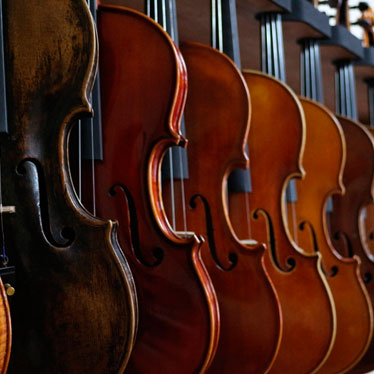What Features To Look For In A Violin For Musicians At Various Levels Of Experience

The craftsmanship and materials employed in creating a stringed instrument like the violin leaves room for many levels of artistry. The painstaking attention to detail, careful selection of tonewoods, and skill required during the fitting out process all combine to form an instrument that projects lighthearted melodies or haunting tunes with equal magnificence.
But, with so many levels and graduations of features, it’s often difficult to know exactly which ones to look for which playing level. Violins have different classifications, but so do the musicians who play them; and finding the right match can be challenging. However, when you do match the instrument with the player, the result is outstanding.
Essentially, you want to match a violin with the player’s skill level because it helps improve the performance of both the instrument, and the musician. These tips can help you make your selection successfully.
Beginners
For students just starting their musical journey, there are a number of features to look for in your violin choice. The most important aspect involved is choosing a violin that offers ease of playability. You’ll want an instrument that will offer a great sound that is simple to produce, yet also one that offers durability.
Some key items to look for include:
- Construction—the violin should feature solid construction. No creaks when you gently apply pressure to the instrument, no visible cracks or seam separations, and a nice, equal alignment. The violin should look symmetrical when looking at it from both the front and back.
- Tonewoods—a quality violin is crafted from Spruce (for the table), Maple (sides/ribs, neck), and other tonewoods such as Ebony for chinrests, fingerboards, and pegs. The type of wood used to make the violin have a huge impact on the way it resonates. The quality of the wood used (and how it is shaped, smoothed, and planed) often determines an instrument’s worth.
- Fine tuners—For new students, fine tuners provide a great way to learn the subtle differences in pitch and tone. They allow students to make smaller adjustments to the strings for easier tuning.
- Great Sound—this can only be judged by actually listening to the instrument. You should take along a few extra pairs of ears and listen to the violin from multiple distances so that you can properly judge the violin. The quality of the strings also affect the sounds produced, so keep that in mind.
- Correct Size—it is dangerous and difficult to play on a violin that is too big. Make sure that you choose an instrument that fits the player’s size.
Although these basic features are good guides for any level musician, it’s particularly important for new students to learn on an instrument that offers rich, smooth tones. Also, consider purchasing an outfit, which contains the violin, bow, and a hard bodied case. Not only is this an affordable option for most beginners, quality-built brands offer exceptional sound and playability. And, it encourages new students by the progress they can swiftly achieve on an excellent violin.
Intermediate
Intermediate players will benefit from all of the same features that make for a great beginner violin, but at this point, the fine tuners are probably not necessary. It simply depends on the player’s preference.
What you’re looking for here is graduations of those features for an intermediate violin. Superior craftsmanship with closer attention to detail provides clearer tones and a more responsive instrument. This means that the violin is able to perform beautifully with more advanced bowing techniques and the sound projection is fuller and richer.
Intermediate instruments also typically feature more pleasing appearance. The finish, scroll work, and other aesthetics are a bit more intricate. However, those features don’t have any impact on playability or sound, which are essentially the most important virtues of any quality instrument.
Advanced/Professionals
For advanced players, it’s important to consider these features in respect to the preferred playing style of the musician. For example, certain strings work better with certain styles. And, it’s a good rule of thumb that as you progress in violin levels, you’ll notice that the instruments themselves become less heavy and more delicate. Again, this is due to the artisan quality woodworking and superior materials that are required for this level of craftsmanship.
But, no matter what level musician you a choosing a violin for, searching for the best possible sound and ease of play are paramount. It really won’t matter how wonderful or costly the violin is if you don’t eagerly want to play it and explore your talents with it. Therefore, take your time and choose a violin that will match the player’s skill and tastes.


